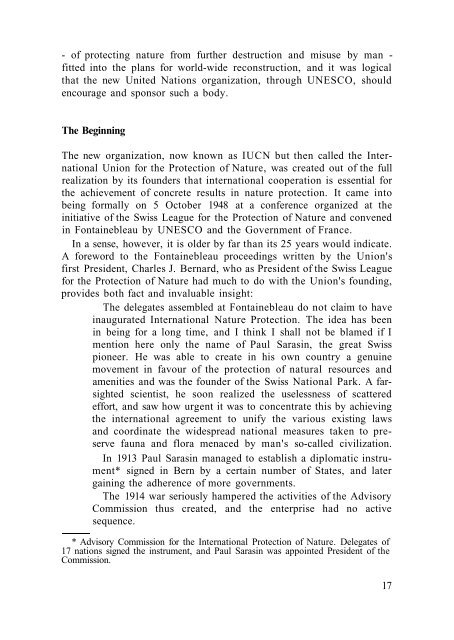1973 iucn yearbook
1973 iucn yearbook
1973 iucn yearbook
Create successful ePaper yourself
Turn your PDF publications into a flip-book with our unique Google optimized e-Paper software.
- of protecting nature from further destruction and misuse by man -<br />
fitted into the plans for world-wide reconstruction, and it was logical<br />
that the new United Nations organization, through UNESCO, should<br />
encourage and sponsor such a body.<br />
The Beginning<br />
The new organization, now known as IUCN but then called the International<br />
Union for the Protection of Nature, was created out of the full<br />
realization by its founders that international cooperation is essential for<br />
the achievement of concrete results in nature protection. It came into<br />
being formally on 5 October 1948 at a conference organized at the<br />
initiative of the Swiss League for the Protection of Nature and convened<br />
in Fontainebleau by UNESCO and the Government of France.<br />
In a sense, however, it is older by far than its 25 years would indicate.<br />
A foreword to the Fontainebleau proceedings written by the Union's<br />
first President, Charles J. Bernard, who as President of the Swiss League<br />
for the Protection of Nature had much to do with the Union's founding,<br />
provides both fact and invaluable insight:<br />
The delegates assembled at Fontainebleau do not claim to have<br />
inaugurated International Nature Protection. The idea has been<br />
in being for a long time, and I think I shall not be blamed if I<br />
mention here only the name of Paul Sarasin, the great Swiss<br />
pioneer. He was able to create in his own country a genuine<br />
movement in favour of the protection of natural resources and<br />
amenities and was the founder of the Swiss National Park. A farsighted<br />
scientist, he soon realized the uselessness of scattered<br />
effort, and saw how urgent it was to concentrate this by achieving<br />
the international agreement to unify the various existing laws<br />
and coordinate the widespread national measures taken to preserve<br />
fauna and flora menaced by man's so-called civilization.<br />
In 1913 Paul Sarasin managed to establish a diplomatic instrument*<br />
signed in Bern by a certain number of States, and later<br />
gaining the adherence of more governments.<br />
The 1914 war seriously hampered the activities of the Advisory<br />
Commission thus created, and the enterprise had no active<br />
sequence.<br />
* Advisory Commission for the International Protection of Nature. Delegates of<br />
17 nations signed the instrument, and Paul Sarasin was appointed President of the<br />
Commission.<br />
17

















